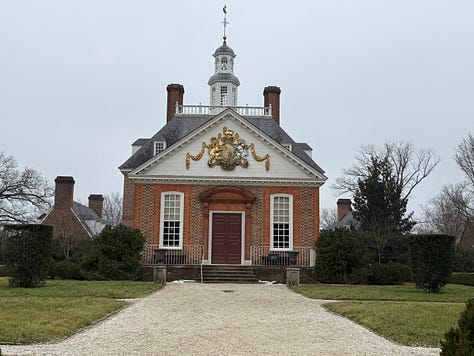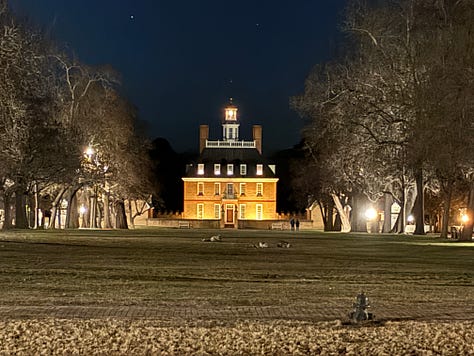And again, it's my garden to the rescue. Always.
Time and time again, my garden grounds me and provides much-needed hope in the bleakest days. To plant a garden is to believe in the future, which is appropriate given that preparations and seed sowing will begin very soon.
I confess, I've been in a dark place this week. Recent hard-right political shifts here in the U.S have been keeping me up at night. Living in the Washington, D.C. region means that many of my friends, neighbors and colleagues are a being laid off en masse from their career civil service positions as the powers-that-be stage an administrative coup. These actions feel the most pressing and economically immediate, but there are so many policy and implementation changes coming every day that it's hard to keep balance. Civil, human and voting rights are under attack domestically, and then there's the head-spinning international situation.
In the garden, it's been a roller coaster recently. It was cold and snowy for a couple of weeks, and then last week it was dramatically warmer. I could see subtle signs that the garden was waking up a bit. But then, this week has been very very cold, well below freezing, and everything outside froze up again. Maryland doesn't have particularly long winters, and if weather predictions are on point, then we are turning the corner towards spring in the next week or so.
Here, on the shores of the Chesapeake Bay in Maryland (USDA Zone 8a), our last frost is usually around April 15th. But it has been shifting in recent years, unpredictably, thanks to climate change.
But that means it's getting close to being time to plant seeds, and to finally do the garden clean up I didn't get around to in the fall. Beds need to be prepped, mulch laid down, pruning needs to be done… It's all getting ready to pick up for the spring start.
I can't wait. The anticipation is killing me.
Squinting into the sun in front of the Governor’s Palace. Note the building’s symmetry.
Friday Field Trip: February 21, 2025
Maybe it's because I have had America’s Founding Fathers on the brain lately, but I've been thinking a lot about a recent wintry weekend my husband and I spent in Williamsburg, Virginia. We had an opportunity to get away for a couple of days, and decided to drive down to soak up some Americana. A former history teacher, I enjoy the efforts of the Colonial Williamsburg Foundation to preserve and maintain the town, and to support education and research into the past for future generations. We are a young country - barely 250 years old - so there is still a lot of political and societal evolution ahead (I hope).
A bit context for those not from here: Williamsburg is a quaint, quiet tidewater Virginia city that is known for it's historic and colonial roots. Home of the College of William and Mary (one of the oldest universities in the U.S.) and the Virginia House of Burgesses, the first democratically-elected legislative body in the British American colonies. Williamsburg became a hotbed of American revolutionary spirit, with George Washington, Thomas Jefferson and Patrick Henry all serving as Burgesses before the American Revolution. The Battle of Yorktown - the final battle of the American Revolution (cue Hamilton lyrics) - was fought nearby. The Colonial Williamsburg Foundation was funded by John D. Rockefeller 100 years ago to preserve/restore the historic structures of the town and to create a living history museum. It's a whole town of historic preservation, reenactments and interpretation (some have been controversial over the years, particularly in terms of the depiction of enslavement and the portrayal of the enslaved in colonial life). I think the most interesting parts are the Trades - they have multiyear apprenticeship programs in colonial trades that are fascinating and I love talking with the craftspeople - printer, bookbinder, weaver, spinner, cooks, blacksmiths, silversmiths, apothecary, wig maker, etc. This all makes the social historian in me very happy.
So, it's safe to say Williamsburg's American history credentials are strong. There are many other historical events that took place in Williamsburg, but for the sake of keeping this garden-relevant, I'll spare you my history nerdery. I know that's not what you're here for.
Back to the gardening - although we visited in mid-January, there were still gardens in production in pockets across the town. (Gardeners and farmers use historical methods to grow foods and plants for use in the kitchens and pubs). Here are a few highlights, a mid-winter's garden travelogue:
Colonial Formality
If you spend any time in colonial parts of the U.S. - particularly in the British colonial mid-Atlantic - you'll see a colonial fashion for symmetry in both buildings, houses, and gardens. My school teachers explained it like this: "if you drew a line down the center of the [building], and imagine folding the building on this line, it will match perfectly on either side". In 18th Century Maryland and Virginia , we took our cultural cues from British designers - formal, refined, symmetrical.
This is on display in Williamsburg in a number of different parts of town, but most clearly in the gardens located behind the Governor's Palace (the seat of Royal authority in the Virginia colony). As Royal appointees, the Governors were loyal British emissaries, lived in the palace and held official meetings there (although the last one, Lord Dunmore, fled as the Revolution kicked off). The Palace is definitely "colonial fancy".
The palace garden has a formal layout, with very English clipped box hedging, distinct rooms, and lots of herbaceous perennials (many were hibernating while we were there, but the design is clear). The effects of box blight are visible, and gardeners are clearly working to contain it. The box maze I remember from childhood visits is gone.



Elsewhere along the main street, there were "town gardens" laid out with similar nods to formality, with evergreen edging along beds. I'd love to come back in spring or summer to see them fully in bloom.
Everyday Gardens
There are also less formal gardens that were still in production in January, despite the recent snow. These gardens included edible plants that can withstand the cold weather, and cooks at the Governor's Palace kitchen use these for ingredients in their historic recipes (There is active research underway into colonial recipes and cooking methods. So cool.) What is evident is the blending of edible plants (in this season, lots of brassicas, as you would expect), and herbs to be used for both cooking and medicinal purposes. The bones of perennials flowering plants are also visible, though clearly not leafed out in winter. Many were labelled as heirloom varieties, and Colonial Williamsburg works to cultivate historically appropriate crops (or close approximations) using historical methods. Everything is organic, obviously.
Red cabbage and fava beans, with herbs in the beds behind.
Arboretum
I am not a tree expert. I've always gardened in smaller and urban spaces, so trees haven't been my go-to plantings. However, I do appreciate the grandeur of trees, the way they measure time, and the care they require once they achieve arboreal old age. There are some very beautiful old trees in Williamsburg, and I learned there's a historic arboretum and trail to visit another time. If you're a "tree person", then you should check it out.
Reflections and Inspiration for Your Weekend
I think what struck me most in our visit was the timelessness of gardens and gardening practices. Here are my biggest takeaways, with hopes that they provide some inspiration for you!
What's Old is New: Gardens are a through-line linking the past and present. Our "new revelations" about practicing organics, bio-diversity and interplanting are not new at all. We are rediscovering the old ways, drawing inspiration from past practices. I think we can heal our world by looking back at what worked without chemical pesticides and fertilizers, and bringing forward best practices for the future.
In one of Williamsburg's shops, I picked up a copy of Culpeper's Complete Herbal, a reference first printed over 350 years ago (and still in print!). First written as a guide to medicinal herbs and their medical uses, this is a very cool read into how plants were used historically. Although I wouldn't look to Culpeper for medical advice (lots of astrology and advice about “humours”), it's fascinating to see how much botanical knowledge from the past still resonates.
Nicholas Culpeper. Culpeper's Complete Herbal: Over 400 herbs and their uses. (1653)
If you're interested in the historical and modern medicinal uses of plants (supported by modern science and fewer “humours”), another great reference is from Kew.
Kew Experts. The Gardener's Companion to Medicinal Plants: An A-Z of Healing Plants and Home Remedies. (2017)
Illustrations from Culpeper’s Complete Herbal, including rye, sage, rice and solomon’s seal.
Don't be Afraid to Mix Edibles and Flowers
Edible plants are beautiful too! Mixing them with flowers is an old practice, steeped in history. Cottage gardens were places where limited real estate was used to produce a family's food and medicine. They were less formal, less designed and very very charming. This is a practice I'm going to lean into more and more - in my kitchen garden and also in my flower beds and borders. Here's what's on my nightstand right now:
Leslie Bennett and Stefani Bittner. The Beautiful Edible Garden: Design a Stylish Outdoor Space Using Vegetables, Fruits and Herbs. (2013)
Resilience is Everywhere, Across Time and Place
Resilience is a buzzword these days. Climate change is making us rethinking what we plant, how we plant and why we do what we do. I took inspiration in seeing the variety that was growing over the winter months in Williamsburg. Heirloom varieties that can withstand challenging conditions are important to how we grow today - hardiness, drought tolerance, flood resilience. These are all characteristics that we can look for to inform how we garden. I'm taking it as a personal challenge to push myself to grow new things and bring some adventure to my garden.
I'm going to start here, and order some new seeds NOW. It's almost time to start planting: Seed Savers Exchange.
And, circling back to the state of our politics right now, I was reminded that we defeated monarchs in the past during a time when we were truly dependent on them for every aspect of our economy. If we could do it then, we can do it again. We can get through these bizarre times.
Lessons from the garden to the rescue again.
The world needs more gardens - and gardeners. Thank you for being here!












